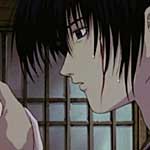 |
|
Does symbolism enhance or detract from the story in "Samurai X?" |
||
Akadot wanted to challenge the two scholastic titans, Matt Yamashita and E.W.C., who surrender their thoughts each month on some of the most frivolous of anime topics, which range from "Pokemon" vs. "Digimon" to who Akane should end up with. This month, we offer the anime fan community a heady, intelligent debate on some more weighty issues.
|
|
Point - Matt George W. is right. America is tired of partisan bickering. From the Senate floor to the hallowed linoleum of Akadot a new spirit of cooperation reigns. Or so my editors would have you believe, as this month's baffling topic is so vague as to make any disagreement between E.W.C. and me impossible. The two of us slugging it out over the symbolism in "Samurai X" makes about as much sense as a unified field theory knife-fight. Some situations demand a more refined dialogue. I extend the olive branch to my distinguished colleague, so that together we can shed some light on this…ahem…most pressing question. Remembering what I can from my days in film school: a symbol, in a cinematic context, is any element of a film, either a story point (like a bleeding cheek) or a visual motif (like falling rose petals) that represents or "symbolizes" an individual or an idea. Rosebud wasn't just a sled - it was Kane's lost youth. And it wasn't just a fourth piece of chocolate cake - it was Welles' struggle with the studio system. Right. Does "Samurai X" employ a lot of symbolism? Well, it better, or the rest of our question doesn't make a lot of sense. How about Kenshin's cut cheek? That's a symbol. Lizuko says so in Episode 1. The un-healed wound represents an un-revenged injustice, and on a larger scale Kenshin's relationship to Tomoe and his own humanity. Obviously the rose petals are a symbol, both of Tomoe's person and of a natural beauty in conflict with man's destructive impulses. Even the drinking of Sake takes on a symbolic component; an individual's relationship to the beverage mirrors his relationship to the rest of the world. |
|||||
|
On to theme: No, gentlemen, the theme of "Samurai X" is not "seeing someone's head get severed". Don't get me wrong. Head slicing is cool. But it's not a theme. At least not the theme of this movie. I like "Beauty and Destruction: A dichotomy and a harmony." I used that as a title for an English paper once and I got an A, so it must be good. "Samurai X" belongs to the bloody, slash-em-up genre, but the characters and the story are transfixed on beauty. The artwork is sumptuous, and the slow motion fight animation imbues swordplay and blood splatter with an aesthetic elegance that resonates louder than the grunts and screams. The character's themselves are very beautiful as is the depiction of the physical world, and the conflict between this beauty and the savagery of the setting and the story line is at the heart of "Samurai X." As character's wrestle with the incongruity of these two elements in their world - trying to bring peace through killing, for example - they are attempting to create harmony between beauty and destruction and find peace within themselves.
Ultimately, much of this theme is communicated through the symbols. The story itself, the action and the dialogue, is unremittingly grim. Symbols like the rose petals and the sake direct the audience's attention away from the murderous action and toward a closer examination of personality and meaning. Even very blatant symbols like the cut cheek get the audience thinking on a different level, searching for added meaning in otherwise mundane events. And if "Samurai X" is to succeed as a highbrow, emotional samurai hybrid (or, as they put it, romantic stories from the Meiji period) it needs this sort of careful watching from a viewer. Let's face it. More than a few people, myself included, would be inclined to watch just for the blood and guts. Does this symbolism detract from the movie as a whole? Maybe a better question is whether this theme detracts from the action? The samurai genre has as its cousin the American Western. Like "Samurai X," films like "High Noon" and "Butch Cassidy and the Sundance Kid" have attempted to infuse more adult themes into what is basically a simple and gratuitous genre. Those films also rely on symbolism to help them make their points (Butch and Sundance's pursuer wore a Panama hat, a namesake of the canal that was to end the wildness of the west). Those films, like "Samurai X," take a little more effort to watch. But I think it's worth it. I'm not completely won over by the symbolic elements of "Samurai X" - they seem a little too heavy-handed at times, and the theme is not as clearly articulated as it is in those Westerns I referenced - but in the end it's good to see people trying to expand the limits of a genre. Particularly when they still provide top-notch head slicing. A final thought: Ang Lee has said that the real counterpart to Asian martial arts films is the American musical - with an emphasis on beautiful choreography. Good news for "Samurai X," as Mr. Lee has done pretty well with his own romantic, symbol-laden, martial-arts movie. Too bad Kenshin can't fly. (Matt Yamashita) |
|||||
|
Counterpoint - E.W.C. This scores about a 3 on a scale of 1 to 10 on the mighty topic-o-meter. Oy vey, do I have to? Fine then... Rurouni Kenshin is loaded with symbols: fine, great. The question is whether these symbols add to or distract from the theme of the movie. I say they're pretty damn distracting, not for me but for the characters. There are a lot of pretty red flowers falling down on the ill-fated characters like crimson rain. One might think all of those flowers would get in the way of people killing one another, but somehow the bloodlust prevails. The scar on Kenshin's cheek and the sake- yes, yes, all symbolic and I couldn't care less. If you want an academic approach to this anime, then check out Matt's column because he's pretty much said it all and in a much more eloquent, if somewhat instructional, fashion. Any attempt on my part to feign interest on the subject would just smack of insincerity. It is not that I lack the creativity for such masturbatory writing (I once got an "A" on an English paper for a book I didn't even read), but I must be discriminating. The only thing I can tell you is this: I know that the symbolism is there and I find it banal because it tries too hard to be noticed.
Symbolism is more effective when it is subversive, when its presence invades your unconsciousness. The opposite approach is like the frantic flailing of a red flag: it lacks subtlety and sophistication. Does "Rurouni Kenshin" (a.k.a "Samurai X") do that? I think so. "Kenshin" uses its symbols just as that - symbols. They make appearances here and there solely for the purpose of enforcing a point. Please keep in mind I'm saying this strictly as a viewer, I'm not a film aficionado like Matt. I know what I like and what I don't like. I like the "Rurouni Kenshin" comedy series but I don't like the stylization of Kenshin's dark past as a batoussai. Although it is appropriate for the OAV to tell Kenshin's troubled beginnings in a dramatic tone, I don't think the imagery is necessary, and neither are the corny sermons - with the exception of the hilarious and somberly spoken sake speeches which sound like they come straight out of a commercial on the Nihon Network. |
|||||
|
My point is symbolism that makes its presence known too often and too quickly in art often robs the viewer from achieving an enlightened discovery. An appropriate and effective way to use symbolism is to manipulate an image or object as a device, an actual tangible object, which leads the viewer to believe that it has no purpose other than what it is designed for. At first the viewer takes the object for granted because we already have an impression of what it means. As a story unfolds and progresses only then do we assign a dual definition to the object: as a representation of its real function in our world, and the interpretation of those abstract concepts with which it is associated. Ultimately symbolism in art as well as in life reflect the individual's psychological mechanisms. It is a universal, but personal language and a key to unlocking our imagination and path of self-discovery. When an individual identifies a significant image or object in art, the associations he or she makes with that object, be it peace, redemption, love, hate, or persecution, reveal those personal ideologies partly responsible for the formation of that individual's self. As viewers we believe we are watching the story of other people, but symbolism takes the story inward. We don't need anyone telling us what it means or why it is important. I wouldn't say the "Kenshin" is so pushy as to force its theme down our throats, but it is often the folly of mediocre films to overuse symbolic imagery and dialogue to direct its audience into a particular point of view. When a symbol is misused in such a fashion it loses its potency and evokes hi-falootin' questions such as the one Matt and I have to respond to. (E.W.C.) The views and opinions expressed in The KareKano column are solely those of Matt Yamashita and E.W.C. and do not necessarily represent the views of Digital Manga, AKADOT or its sponsors.
Samurai X / Rurouni Kenshin © Nobuhiro Watsuki / Shueisha / Fuji TV / SPE Visual Works / AD Vision.
|
|||

